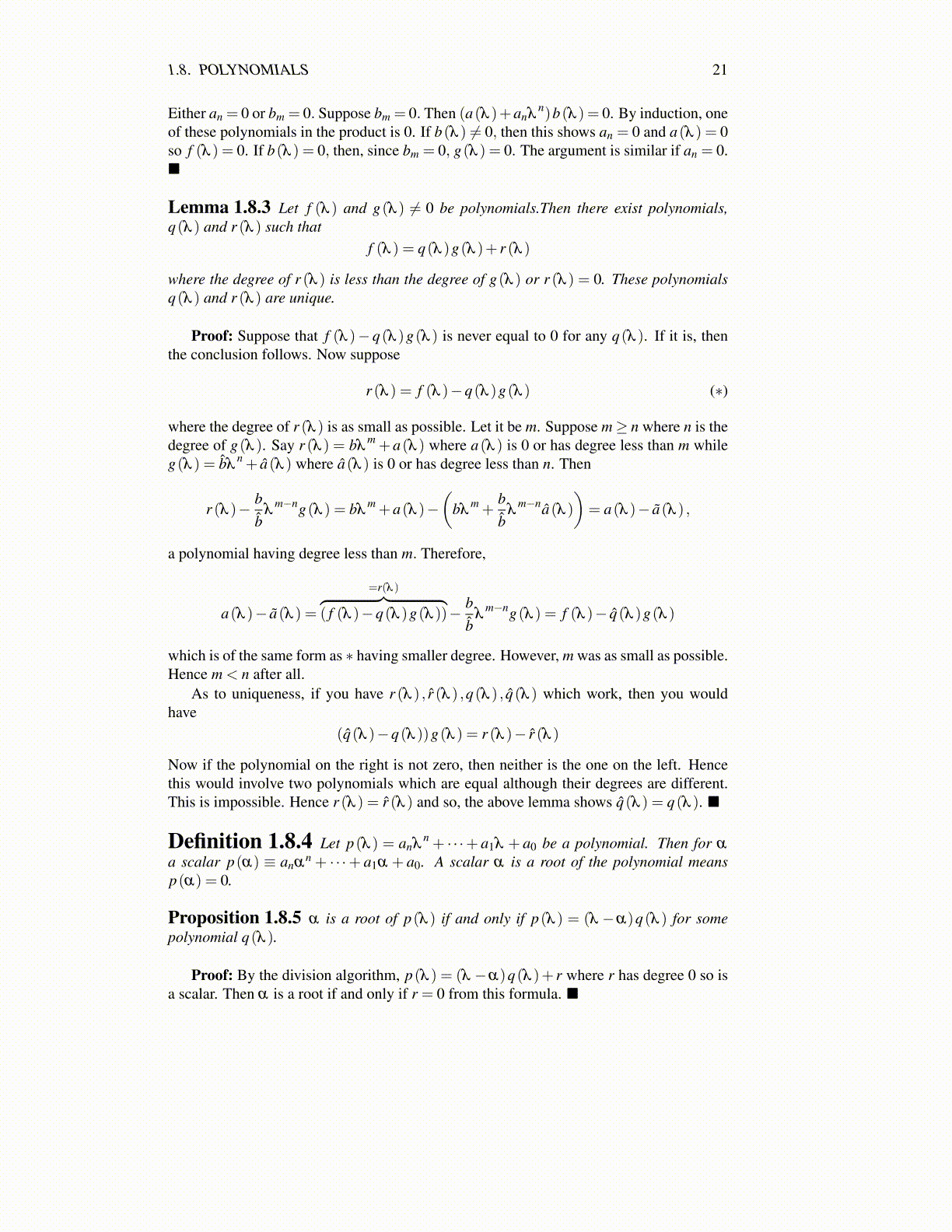
1.8. POLYNOMIALS 21
Either an = 0 or bm = 0. Suppose bm = 0. Then (a(λ )+anλn)b(λ ) = 0. By induction, one
of these polynomials in the product is 0. If b(λ ) ̸= 0, then this shows an = 0 and a(λ ) = 0so f (λ ) = 0. If b(λ ) = 0, then, since bm = 0, g(λ ) = 0. The argument is similar if an = 0.■
Lemma 1.8.3 Let f (λ ) and g(λ ) ̸= 0 be polynomials.Then there exist polynomials,q(λ ) and r (λ ) such that
f (λ ) = q(λ )g(λ )+ r (λ )
where the degree of r (λ ) is less than the degree of g(λ ) or r (λ ) = 0. These polynomialsq(λ ) and r (λ ) are unique.
Proof: Suppose that f (λ )− q(λ )g(λ ) is never equal to 0 for any q(λ ). If it is, thenthe conclusion follows. Now suppose
r (λ ) = f (λ )−q(λ )g(λ ) (∗)
where the degree of r (λ ) is as small as possible. Let it be m. Suppose m≥ n where n is thedegree of g(λ ). Say r (λ ) = bλ
m +a(λ ) where a(λ ) is 0 or has degree less than m whileg(λ ) = b̂λ
n + â(λ ) where â(λ ) is 0 or has degree less than n. Then
r (λ )− bb̂
λm−ng(λ ) = bλ
m +a(λ )−(
bλm +
bb̂
λm−nâ(λ )
)= a(λ )− ã(λ ) ,
a polynomial having degree less than m. Therefore,
a(λ )− ã(λ ) =
=r(λ )︷ ︸︸ ︷( f (λ )−q(λ )g(λ ))− b
b̂λ
m−ng(λ ) = f (λ )− q̂(λ )g(λ )
which is of the same form as ∗ having smaller degree. However, m was as small as possible.Hence m < n after all.
As to uniqueness, if you have r (λ ) , r̂ (λ ) ,q(λ ) , q̂(λ ) which work, then you wouldhave
(q̂(λ )−q(λ ))g(λ ) = r (λ )− r̂ (λ )
Now if the polynomial on the right is not zero, then neither is the one on the left. Hencethis would involve two polynomials which are equal although their degrees are different.This is impossible. Hence r (λ ) = r̂ (λ ) and so, the above lemma shows q̂(λ ) = q(λ ). ■
Definition 1.8.4 Let p(λ ) = anλn + · · ·+ a1λ + a0 be a polynomial. Then for α
a scalar p(α) ≡ anαn + · · ·+ a1α + a0. A scalar α is a root of the polynomial meansp(α) = 0.
Proposition 1.8.5 α is a root of p(λ ) if and only if p(λ ) = (λ −α)q(λ ) for somepolynomial q(λ ).
Proof: By the division algorithm, p(λ ) = (λ −α)q(λ )+ r where r has degree 0 so isa scalar. Then α is a root if and only if r = 0 from this formula. ■